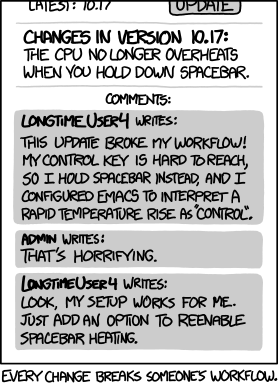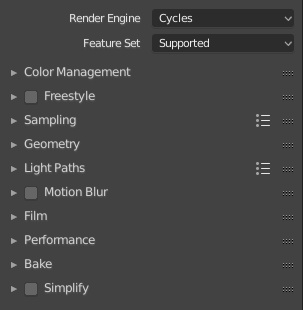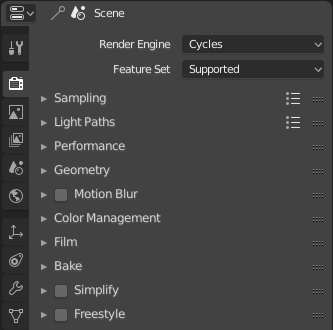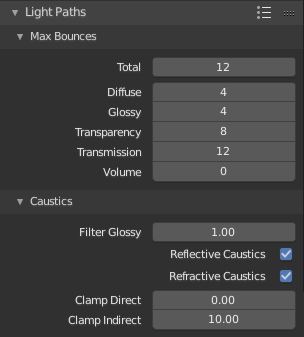Hi,
since 2.8 is a time for bigger UI changes, I would suggest to improve the most prominent deficiencies when it comes to Cycles render settings. They are quite confusing or overcomplicated at some places, but recent introduction of single column layout, which breaks the ability to suggest functionality of various render settings by their proximity to others made these deficiencies that much more apparent.
So, here we go:
Removals:
Clamp Direct should be removed:
I have yet to see a single use case or or scene where clamping direct lighting results in any significant performance boost/noise reduction without completely ruining direct light transport accuracy. While clamping indirect lighting makes a lot of sense, clamping direct doesn’t. That’s why no other renderer out there implements such option.
Pattern:
Performance benefits of choosing Sobol over CMJ are pretty much random and inconsistent. A good default should be chosen and this option should be hidden. The technicalities behind this option are so complex that no user who is not a renderer programmer at the same time would be able to make an educated guess on which one to use anyway.
Reflective and Refractive caustics:
There is not a single use case where it makes sense to disable either reflective or refractive caustics completely, when we have indirect light clamping already. These two toggles mean that refractive materials will cast completely opaque shadows and that metallic materials will bounce no light at all. Both of these effects severely compromise light transport accuracy while posing nearly no performance benefit over using indirect clamping with some low value (like 1-2)
Square samples:
It was implemented with a good intention, but it just creates another unnecessary layer of complexity for both new and existing users to deal with. Especially if they decide to exchange their render settings and some of they may use it while others don’t. These days, Cycles is optimized well enough that it’s rare to ever see users inputting such a large numbers of samples in UI sliders that it makes sense to have a specific feature to alleviate it.
Overall, the reason to remove these is that the benefits or flexibility these options bring are so small they do not outweigh the drawback of making Cycles harder to use by polluting render properties panel with settings which significantly increase room for user’s error.
What I mean by that is that chances any of these settings will be used in a wrong way, which is harmful to resulting image quality is significantly larger than chances someone will utilize these settings in a good way.
Naming improvements:
Light Paths category → Ray Depths:
Chances are that both new users and existing users with some rendering experience will be able to associate term “rays” with tracing depth rather than “light paths”. While Cycles technically is a path tracer, if I was a new user, just learning about computer graphics, the term “path” would certainly be more confusing to me. Generally, if you ask people around how would they expect a panel of settings to control ray tracing depth to be named, not many of them would say “light paths”.
Transparency → Opacity:
Transparency is quite ambiguous term. While in some renderers it means refraction, in others, like Cycles, it means opacity. Opacity is a term which would remove any ambiguity out of the terminology. You will often hear artists talk about opacity maps, but rarely transpancy maps. And if you hear transparency maps, they are most likely talking about refraction amount map, or something like that.
Glossy → Reflection:
Term “Glossy” kind of implies this sampling value is only used for reflective surfaces either above or below certain roughness, depending on if the user is used to glossiness or roughness workflow. This is again ambiguous. Naming it reflection would send a clear message that the ray depth affects all reflections.
Transmission → Refraction.
Transmission is a term rarely used in any rendering engines made for consumers, not scientists. And those few rare times it’s actually mentioned in some consumer renderer, it’s usually in conjunction with Diffuse Transmission, rather than refraction. Vast majority of new users or users coming from other renderers will be looking for refraction ray depth and wondering why in the world they can’t find it.
Geometry (roll-out) → Hair and Volume
You have no idea how many times I was looking for volume step size and forgot where it was, when I finally found it in the roll-out which as little descriptive of its contents as possible. ![]() This again comes down to programmers often using quite different association of the terminology than users, but the fact is this UI is supposed to be used mainly by users, so some compromises should be made.
This again comes down to programmers often using quite different association of the terminology than users, but the fact is this UI is supposed to be used mainly by users, so some compromises should be made.
Film → Framebuffer:
Film roll-out mostly contains frame buffer settings, while the term “Film” will most likely evoke things like camera response curve in most of the users.
Merging:
I’d suggest to merge Film roll-out with Post Processing roll-out. They both contain same category of settings, and it appears division of the settings they contain into these two categories is rather arbitrary, than based on some deep logic. This will save us one roll-out.
All in all, I am quite confident that with these changes, Cycles would become a bit easier for users to pick up.




